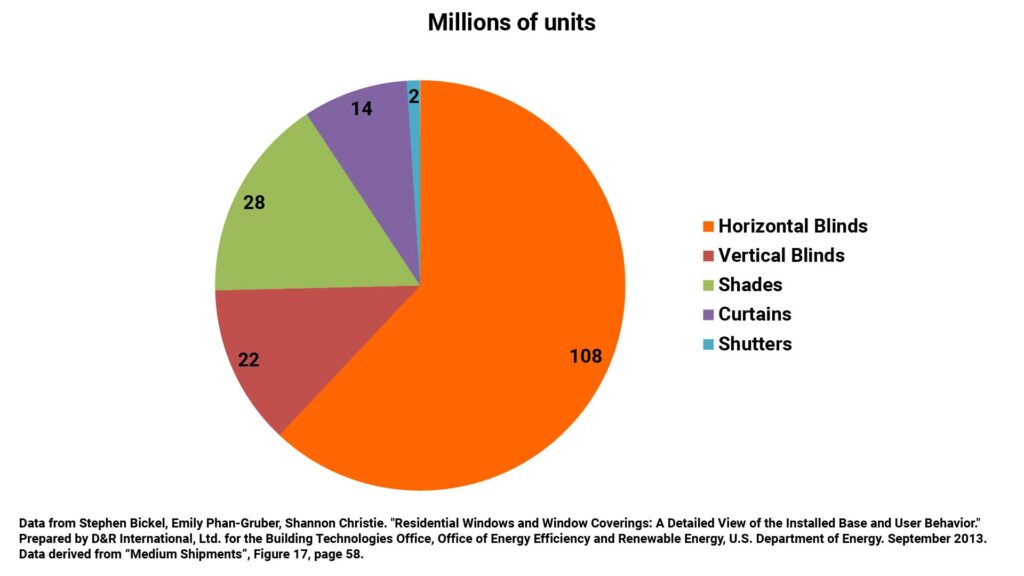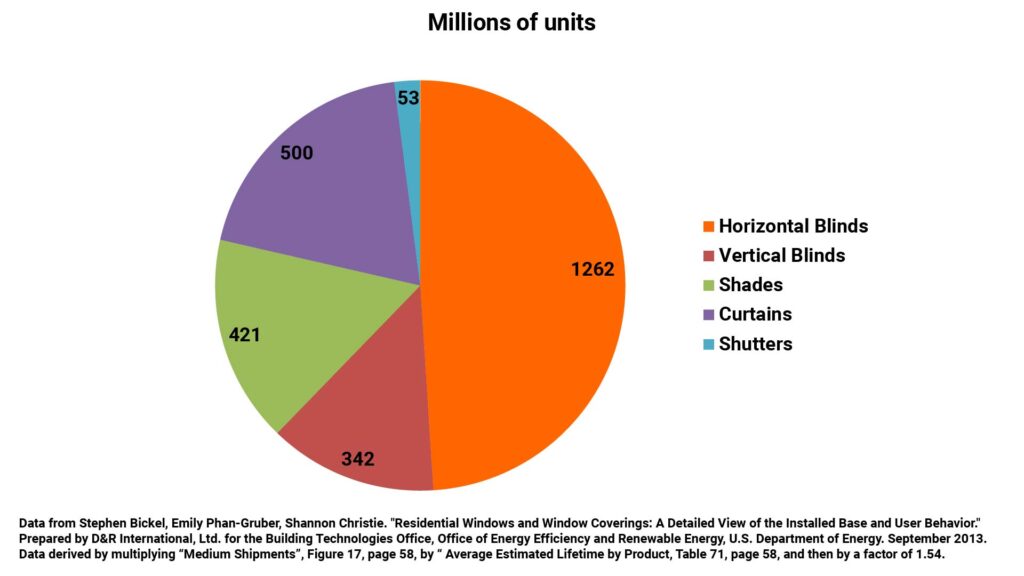Why Motorized Horizontal Blinds Will Dominate the U.S. Automated Shading Market
Automated window shading represents a huge market opportunity that’s still mostly untapped. However, after decades of being stuck at less than a few percent of the overall window coverings market, automated shading products are finally starting to gain traction in the U.S. This nascent growth is being fueled by significant reductions in price, as well as by increased interest in smart products in general.
All types of automated interior shading products—motorized blinds, motorized roller shades, motorized pleated shades, motorized curtains, and Smart Windows—will eventually benefit from this growth. However, one type of automated shading product in particular appears poised to dominate the U.S. market: the motorized horizontal blind.
Horizontal Blinds Have Dominated the U.S. Window Coverings Market for Decades
The horizontal blind has been the most widely used window covering in U.S. commercial buildings since the early 20th century. And after the modern mini-blind was introduced in the 1970’s, the horizontal blind also went on to thoroughly dominate the residential window-coverings market, too.
Much of the market research on window coverings is located behind paywalls. However, a good idea of the dominance of horizontal blinds can be gleaned from a freely-accessible 2013 report (Bickel et al, 2013), commissioned by the U.S. Department of Energy, on the usage of residential window coverings in the U.S.
While the report was published back in 2013 (and relies on source data for the years 2007 – 2011), there is enough inertia in the market that the estimates are still useful—and probably just as (if not more) accurate than information from other sources. By the way, in addition to market information, the report also provides a wealth of statistics on how people actually operate residential window coverings in the U.S., but that’s beyond the scope of this post.
While the report includes dozens of figures and tables, the salient information for the purposes of this post can be summarized in just three figures that address (1) the annual shipments of residential window coverings in the U.S.; (2) the installed base of residential window coverings in the U.S.; and (3) the installed base of window coverings in both residential and commercial buildings in the U.S.:



Thus, there can be no doubt that the horizontal blind is the most widely-used interior window covering in the U.S., by far. But even more compelling is the sheer number of installed horizontal blinds—almost 1.3 billion units. Even if these estimates are wildly off, there’s clearly an enormous market that’s still mostly untapped.
However, this massive installed base isn’t the only reason that motorized horizontal blinds will dominate the smart-shading market.
The Horizontal Blind is the Most Cost-Effective Daylight-Control Device Ever Developed
First, let’s address two limitations of the horizontal blind (and which apply to all venetian blinds in general): the horizontal blind can’t replace blackout shades to provide near-complete darkness in daytime, and it can’t provide as much thermal insulation as shades or curtains.
But when it comes to controlling the daylight admitted by a window, the horizontal blind is superior to all other window coverings—and it even rivals the most advanced Smart Windows (at just a fraction of the cost). This advantage comes from the horizontal blind’s slat-tilt function.
Slat Tilt Provides Variable Transmittance
Tilting a blind’s slats smoothly adjusts the visible transmittance over the entire window area at the same time (like a Smart Window). On the other hand, drawing a blind’s slats (or operating a curtain or shade) varies the shaded area of the window, and hence the area of the aperture through which daylight is admitted.
The former is a better way of controlling daylight because it gradually adjusts the luminance contrast between the window and surrounding room surfaces…and contrast is what causes glare. In contrast (pun intended), varying the shaded area of the window often doesn’t change the contrast significantly unless the shading is fully closed.

Blinds Can Block Direct Sunlight While Admitting Diffuse Daylight
Horizontal blinds can completely block direct sunlight while still admitting useful, glare-free diffuse daylight. Smart windows can’t do that—and other window coverings can’t do it nearly as well.
For example, cellular and roller shades have to be almost fully closed to block direct sunlight when the sun is low on the horizon. On the other hand, when a blind’s slats are tilted just enough to block the direct solar path, they can also admit plenty of diffuse daylight via reflections between the slats and from the ground outside the window:

Automation Can Unlock the Full Potential of Horizontal Blinds
Along with low cost, the horizontal blind’s superiority for daylight control has been a major factor in its market dominance. However, fully exploiting this advantage depends on adjusting the slat tilt angle with changing sky conditions…and that’s just not practical with manually operated blinds.
That’s where automation comes in. The right kind of automation can fully unlock the horizontal blind’s potential for daylight control, cementing its superiority over other automated window coverings and even rivaling Smart Windows. In fact, motorized blinds are far more cost-effective than Smart Windows for energy savings, and will remain so for the foreseeable future.
Note, however, that automating a horizontal blind (or even a Smart Window) to respond automatically to changing daylight levels isn’t as easy as it might seem. We call this responsive daylight control, and while it’s arguably the most valuable form of the five levels of shading automation, it’s also the most challenging to implement.
Horizontal Blinds are Easier and Less Expensive to Automate than Other Window Coverings
Another advantage which has made the horizontal blind so popular is that the slat-tilt function requires very little physical effort to operate—far less than raising the slats, and far less than manual adjustments with other types of window covering:
- Slat tilt adjustments involve only rotation of the blind’s internal tilt rod; no weight is lifted or lowered.
- Rotation of the tilt rod involves far less friction than, for example, drawing a curtain or the slats of a vertical blind.
- In addition to requiring relatively little torque, adjusting a blind’s slat tilt from one extreme to the other involves less than a 180-degree rotation of the blind’s internal tilt rod, further reducing the mechanical work per shading adjustment.
In addition to facilitating manual operation, these advantages mean that the slat-tilt function of a venetian blind can be automated with a smaller motor, and with lower power consumption, than is possible with any other type of manually operated shading device. This makes slat-tilt motorization far more amenable battery and solar power than any other type of window covering motorization.
The Horizontal Blind is Especially Amenable to Retrofit Automation
As with any mature product category, the installed base of previously sold window coverings dwarfs the annual sales of new window coverings, making retrofit automation the most lucrative segment of the potential automated shading market. And one type of horizontal blind—the wand-operated miniblind—is better suited for retrofit automation than any other type of window covering.
That’s because the slat-tilt function of a wand-operated miniblind can be automated by simply replacing the wand with a motorized automation device; there is no need to modify or even remove the host blind.
A variety of approaches have been used to implement such a motorized automation device, such as the motorized wand approach first disclosed in U.S. patent 5,603,371 and the rotating collar approach first disclosed in U.S. patent 5,495,153:

These patents were decades ahead of their time because the other technologies needed to exploit their potential— such as high-performance microcontrollers with wireless connectivity, smartphones, home-automation platforms, etc.—didn’t yet exist. Today, however, both of these motorization approaches (as well as others) are being used by products currently in the marketplace.
The Market for Retrofit Automation Products for Wand-Operated Blinds is Poised to Explode
The ease with which wand-operated blinds can be retrofitted for motorized operation is especially significant for the U.S. market.
Based on a sample of dozens of office buildings and window-covering distributors, we estimate that fully two-thirds of horizontal blinds in the U.S. have wand-actuated tilt mechanisms. Combining that two-thirds estimate with the previously-cited data from Bickel et al yields the following breakdown of the horizontal blind installed base in the U.S.:

Note that the estimated number of wand-operated blinds (including both metal/vinyl and wood/faux wood) is fully three-quarters of a billion units.
Given the cost-effectiveness of horizontal blinds and this enormous installed base, it’s no wonder that sales of retrofit automation products for wand-operated blinds are starting to take off.
References
Stephen Bickel, Emily Phan-Gruber, Shannon Christie. “Residential Windows and Window Coverings: A Detailed View of the Installed Base and User Behavior.” Prepared by D&R International, Ltd. for the Building Technologies Office, Office of Energy Efficiency and Renewable Energy, U.S. Department of Energy. September 2013. <https://www.energy.gov/sites/prod/files/2013/11/f5/residential_windows_coverings.pdf>
